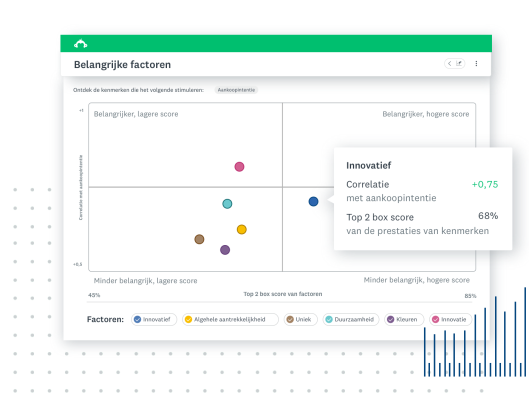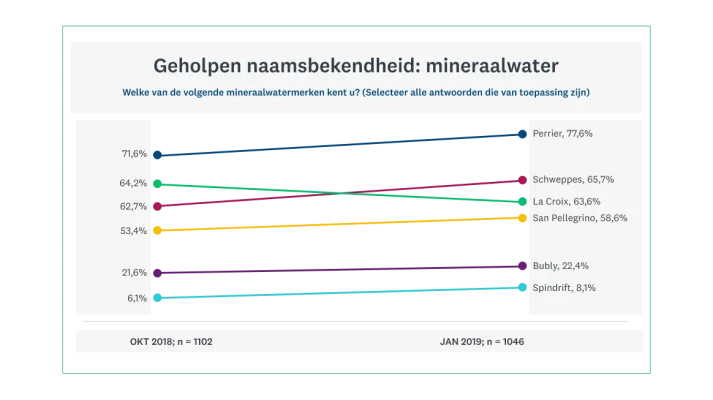More Resources
Wat is doelgroepanalyse?
Een doelgroepanalyse (soms ook wel een onderzoek naar gebruik en houdingen genoemd) is een populair onderzoek met enquêtes dat wordt gebruikt binnen marktonderzoek om de markt grondig te leren kennen, te weten wie wat koopt, waar en hoe vaak, en om het verband te verkennen tussen meningen/houdingen en de gewoonten van consumenten. U vindt antwoorden op veelgestelde vragen zoals:
- Waarvoor wordt mijn product of merk gebruikt?
- Gebruiken verschillende soorten klanten mijn product of merk op verschillende manieren?
- Zijn er verschillende patronen te herkennen in het typische gebruik van mijn product?
- Gebruiken bepaalde segmenten van consumenten mijn product vaker of minder vaak?
- Gebruiken klanten alleen mijn product of gebruiken ze producten van concurrenten? En zo ja, welke dan?
U kunt kiezen uit vier verschillende doelgroepanalyses om deze vragen te beantwoorden. De exacte aanpak is afhankelijk van uw behoeften. Misschien combineert u de volgende werkwijzen wel, of kiest u voor één aanpak.
- Een benadering om inzicht in een categorie te krijgen. Het doel van dit type doelgroepanalyse is om de eigenschappen van de markt als geheel op een rijtje te zetten. Stel u verkoopt kleding online. Misschien wilt u dan wel meer weten over de eigenschappen van de typische online modeshopper. Wanneer winkelen ze, hoe vaak en hoe (bijv. mobiel, tablet of laptop)?
- Een benadering om inzicht in de marktomvang te krijgen. Bij dit type doelgroepanalyse wilt u bepalen in hoeverre verschillende productcategorieën de markt hebben gepenetreerd, evenals de frequentie van het gebruik of de consumptie. Bijvoorbeeld, zelfs als u allerlei verschillende kleding verkoopt in uw webwinkel, dan kunnen online shoppers nog steeds een voorkeur hebben om bepaalde kledingstukken (zoals ondergoed) in een fysieke winkel te kopen, waar ze items kunnen passen of de stof kunnen voelen. Met deze kennis kunt u allerlei marketingbeslissingen onderbouwen, zoals wat u op voorraad hebt, wat u moet promoten en aan wie.
- Een benadering om inzicht in een merk te krijgen. U kunt een doelgroepanalyse uitvoeren om inzicht te krijgen in variabelen zoals merkpenetratie, merkperceptie, merkwaarde en drijfveren voor het kiezen van een merk. Al deze factoren zijn onmisbaar bij het ontwikkelen van uw concurrentiestrategie.
- Een benadering rondom targeting. Een doelgroepanalyse kan ook cruciale informatie aan het licht brengen waarmee u klanten kunt segmenteren op basis van hun houdingen en gedrag. Zo kunt u uw targeting en boodschappen verbeteren.
Hoe goed kent u uw doelmarkt?
Ga op zoek naar de drijfveren en behoeften van uw gebruiker met onze oplossing Gebruik en houdingen.
Wanneer kunt u het beste een doelgroepanalyse uitvoeren?
Een van de belangrijkste voordelen van een doelgroepanalyse is dat het een veelzijdig instrument is en dat u het daarom voor allerlei toepassingen kunt inzetten. Vooral bij de volgende behoeften is een doelgroepanalyse een uitkomst:
- U wilt de wensen en knelpunten van klanten beter begrijpen
- U denkt dat u kansen misloopt op aanvullend gebruik en meer consumptie
- U staat op het punt om nieuwe productcategorieën of marketingstrategieën te ontwikkelen
- U wilt meer inzicht in het bredere concurrentielandschap
Doelstellingen van een doelgroepanalyse
De nieuwste trends observeren in het gedrag van kopers die bepalend zijn voor de marktdynamiek in uw bedrijfstak
De manier waarop kopers over producten en diensten denken, is voortdurend in beweging. En dat heeft gevolgen voor hun koopgedrag. De veranderingen in hun houdingen en gebruik vloeien niet alleen voort uit uw communicatie met hen (bijvoorbeeld via uw marketingcampagnes), maar ook uit de acties van uw concurrenten en algemene verschuivingen op de markt. De Covid-19-pandemie is een geweldig voorbeeld: producenten van alcoholische dranken merkten bijvoorbeeld dat consumenten niet alleen meer uitgaven aan wijn en sterke drank om thuis op te drinken, maar dat de gemiddelde uitgaven per consument ook stegen. Bij zulke verschuivingen in consumptiepatronen, of bij verstoringen in de bedrijfstak, is het tijd om het gebruik en de houdingen van consumenten in kaart te brengen om zo uw vervolgstappen beter te onderbouwen.
Gedetailleerde informatie verzamelen over uw klanten en hun gebruik om de acceptatie en de aankoop van uw producten of services te stimuleren
Zodra een klant uw product mee naar huis neemt, is de transactie voltooid. Of toch niet?
Soms steken we alleen energie in de aanbodzijde van ons bedrijf: de omzet verhogen. Maar we vergeten hoe onze producten aansluiten op het alledaagse leven van onze klanten zodra ze de winkel verlaten. Als u het gebruik van klanten tot in detail begrijpt, weet u zeker dat uw product ook echt bij de klant past en dat u aan specifieke behoeften voldoet. Dat kan dan weer tot meer omzet leiden. Stel uw belangrijkste product is een fitnessapparaat voor thuisgebruik. Door rustig na te gaan hoe klanten het gebruiken, zoals in welke kamer, hoe vaak ze sporten en hoe gezinsleden beurtelings het apparaat gebruiken, kunt u de ontwikkeling van nieuwe producten onderbouwen en uw marketingcampagnes relevanter maken. Misschien ziet u dat jongere familieleden het apparaat wel willen gebruiken, maar dat het formaat niet kindvriendelijk is. U kunt dan fitnessapparaten ontwikkelen die speciaal voor kinderen zijn.
De vraag naar uw producten in kaart brengen om uw aanbod tijdens elke fase van de ontwikkeling te verfijnen: ideeën, ontwikkeling, de markt betreden en herhalen
Een ander doel van een doelgroepanalyse is om de vraag van klanten naar uw producten te meten bij een doelgroep. Met die informatie kunt u uw positionering en productaanbod aanpassen, zodat u zich in de best mogelijke positie bevindt om de omzet te verhogen. Stel u verkoopt yogamatten en u wilt uw markt uitbreiden door meer beginners te bereiken. Op basis van de resultaten uit een doelgroepanalyse die niet alleen de algehele vraag naar yoga evalueert, maar ook onderzoekt waar yogamatten worden gebruikt (bijvoorbeeld in huis of in een openbare studio) en hoe (de soorten oefeningen), kunt u een geïllustreerde mat ontwikkelen waarop beginners kunnen zien waar ze hun voeten moeten neerzetten bij populaire oefeningen. Anders gezegd, u creëert een innovatief product dat beter aan de behoeften van uw klanten voldoet en de interesse in uw merk aanwakkert.

Toekomstige strategieën onderbouwen
Bereidt u zich voor op een significante verandering, zoals een nieuwe reeks producten, een grootschalige reclamecampagne, een uitbreiding van uw merk of het betreden van een nieuwe markt? Dan is onderzoek naar gebruik en houdingen absoluut onmisbaar. U weet pas of uw sprong in het diepe slaagt als u over gedetailleerde, actuele kennis beschikt over uw klanten, hun gebruikspatronen en hun houdingen ten opzichte van uw merk en andere. Met een doelgroepanalyse kunt u duidelijkheid krijgen bij deze kwesties, zodat u uw strategieën kunt vormgeven en optimaliseren.
In het algemeen kunt u via een doelgroepanalyse kansen vinden om uw bedrijf uit te breiden met behulp van een geoptimaliseerde strategie voor uw merk en product. We gaan kijken hoe u dit onderzoek in de praktijk brengt.
Methodologie voor een doelgroepanalyse
U kunt een doelgroepanalyse op een paar verschillende manieren uitvoeren. Maar een van de meest effectieve manieren volgt het traditionele verkoopmodel met een conversietrechter. U begint dan met een algemeen begrip van uw markt en focust dan steeds meer op de specifieke wijze waarop ze met uw merk omgaan en hoe ze het zien. We gaan elke stap bekijken.
Stap 1: Kies de juiste steekproef
Hoewel de data uit een doelgroepanalyse enorm waardevol kunnen zijn, geven veel bedrijven na de eerste horde al op. Dit komt omdat ze geen geschikte steekproef hebben genomen. Het is heel belangrijk dat de steekproef die u gebruikt om gegevens te verzamelen ook echt representatief is voor uw klantenbestand. Bevat uw steekproef bijvoorbeeld te veel oudere respondenten die liever in de stad kleding kopen dan online, dan is uw beoordeling van de houdingen en het gedrag van uw markt waarschijnlijk niet nauwkeurig. Het is belangrijk dat u uw doelgroep zorgvuldig kalibreert, zodat die een goede afspiegeling is van uw klanten wat betreft demografische gegevens, psychografische gegevens en gedrag. Weet u niet zeker hoe u dit aanpakt? Wij hebben een gebruiksklare groep respondenten die u kunt aanpassen op basis van gender, inkomen, arbeidsstatus en meer.

Algemene bevolking (middelgrote steekproef)
- Alle genders (landelijk gemiddelde)
- Alle leeftijden
- Alle inkomens
- 500 reacties, Nederland - SurveyMonkey

Fulltime werknemers
- Alle genders (landelijk gemiddelde)
- Alle leeftijden (landelijk basisgemiddelde)
- Alle inkomens
- Fulltime baan
- 250 reacties, Nederland - SurveyMonkey

Winkelende consumenten
- Alle genders (landelijk gemiddelde)
- Alle leeftijden (landelijk basisgemiddelde)
- Alle inkomens
- Primaire beslisser in huishouden
- 250 reacties, Nederland - SurveyMonkey
Stap 2: Vraag respondenten actief naar wat ze zich herinneren om zo een uitgangswaarde vast te stellen
Een doelgroepanalyse wordt vaak gebruikt om een uitgangswaarde vast te stellen voor toekomstige marketingbeslissingen. Op vergelijkbare wijze kunt u met het eerste deel van een enquête over gebruik en houdingen een referentiekader ontwikkelen voor aanvullend onderzoek. Als u respondenten vraagt om merken of producten uit een specifieke categorie te noemen die ze meteen ongevraagd te binnen schieten, dan krijgt u een goed idee of ze zich bewust zijn van uw merk in vergelijking tot concurrerende merken. Ook weet u of uw recente marketingcampagnes effectief waren.
Stap 3: Ga na wat de houdingen en het gebruik ten aanzien van specifieke merken zijn
Vervolgens gaat u via de enquête de houdingen en het gebruik van klanten verkennen ten aanzien van specifieke producten of merken. U kunt respondenten actief vragen naar wat ze zich herinneren. Misschien noemt u een lijst met concurrerende merken en vraagt u respondenten dan welke ze kennen, welke ze momenteel gebruiken en welke ze hebben overwogen.

Stap 4: Verzamel details
U hebt gevraagd hoe het zit met de kennis en het gebruik rondom een merk. Nu gaat u dieper in op de perceptie van klanten van uw merk en misschien dat van uw concurrenten. Stel u hebt een webwinkel met premium kleding. Zien uw klanten uw merk ook echt als premium? Of zijn er concurrerende winkels die klanten nog luxer vinden? Door te vragen naar de perceptie van uw positionering, krijgt u een beter beeld van de plaatsing van uw merk binnen de bestaande markt en hoe u het doet ten opzichte van concurrenten.
Vragen in een enquête over gebruik en houdingen
Knelpunten, behoeften en wensen
Misschien verkoopt u bestaande producten of diensten aan een bekende markt? Of ontwikkelt u nieuwe producten? Dan is het cruciaal om een profiel van uw doelconsument op te stellen. Door een doelgroepanalyse uit te voeren om de behoeften, wensen en knelpunten van klanten te verzamelen, begrijpt u tot in detail wie uw klanten zijn, wat ze willen en waarom. U kunt voor deze inzichten gesloten en open vragen gebruiken. Kiest u bijvoorbeeld voor open vragen, dan kan dit een optie zijn:
- Wat vindt u het meest frustrerend aan het shoppen naar kleding online?
- Waarom koopt u geen kleding online?
Of misschien stelt u wel gesloten vragen, zoals:
- Als u een onbeperkt budget zou hebben, zou u dan meer uitgeven aan kleding online of offline? [online/offline]
- Wanneer u kleding online koopt, welke van de volgende factoren is dan het belangrijkst voor u? [de prijs/de pasvorm/de kwaliteit/ethische overwegingen/het merk]
Stel de vragen waarop u altijd al een antwoord wilde
Weet precies wat uw doelmarkt wil met de oplossing van SurveyMonkey voor Gebruik en houdingen.
Houdingen en gebruik ten aanzien van uw merk of product
Zoals de naam al duidelijk maakt, moet u de vragen in een enquête over gebruik en houdingen zo formuleren dat u meer te weten komt over de houdingen en het gedrag van consumenten tijdens het klantentraject. Leg de nadruk dus op de perceptie van de producten, wat klanten vinden van uw aanbod en hoe ze uw producten gebruiken in hun dagelijks leven. Een simpel voorbeeld:
- Hoe vaak shopt u online voor nieuwe kleding?
Met alleen al de antwoorden op deze vraag kunt u uw markt segmenteren op basis van consumptiegedrag. Misschien ziet u wel dat u drie markten bedient: klanten die niet vaak online winkelen, klanten die nooit online winkelen en klanten die elke dag online winkelen. Door deze antwoorden te analyseren samen met de antwoorden op vragen over de ervaringen van consumenten die online winkelen (of hun houding ten opzichte van online winkelen), verzamelt u gedetailleerde inzichten waarmee u aan de behoeften van elk segment voldoet. Ook kunt u nieuwe producten of diensten afstemmen op de juiste segmenten en zijn uw klanten keer op keer tevreden.
Houdingen ten opzichte van concurrenten
Bij een doelgroepanalyse beoordeelt u niet alleen de houdingen van klanten ten opzichte van uw eigen merk- en productcategorieën. Vergelijkingsvragen kunnen krachtige inzichten opleveren in uw positionering ten opzichte van uw concurrenten. Misschien laat u respondenten wel een lijst zien van concurrerende producten en merken. Ze rangschikken deze lijst dan van hun meest favoriete tot hun minst favoriete. Of u kunt specifieke vragen stellen over de relatieve kenmerken van verschillende producten in een enkele categorie, zoals:
- Welk van de volgende merken heeft volgens u de beste kwaliteit?
- Welk van de volgende merken is volgens u het meest betrouwbaar?
- Welk van de volgende merken is volgens u het meest ethisch?
Koopgewoonten
Vragen die het winkel- en koopgedrag vastleggen, zijn onmisbaar om de juiste promotie-, positionerings- en distributiestrategieën op te stellen die de omzet bewezen verhogen. Dit zijn nuttige soorten vragen:
- Vragen over de soorten winkels die uw respondenten bezoeken
- Vragen over de triggers die tot een aankoop leiden
- Vragen over belemmeringen die ze ervaren bij een aankoop
- Vragen over hun loyaliteit ten opzichte van u en concurrenten
Tips voor een doelgroepanalyse
Een doelgroepanalyse levert bedrijven waardevolle basisinformatie op over hun markt en klanten. Maar een slecht ontworpen enquête over gebruik en houdingen kan de bruikbaarheid van de resultaten ondermijnen. Met de volgende tips weet u zeker dat uw enquête over gebruik en houdingen inzichten oplevert die u in de praktijk kunt brengen.
- Kies een doelstelling voor de enquête. U moet precies weten waarvoor u de gegevens wilt gebruiken nadat u deze hebt verzameld.
- Stel een interactieve, interessante enquête op. Soms vinden respondenten het lastig om zich te herinneren of te beschrijven hoe ze producten gebruiken in alledaagse situaties. Gebruik verschillende media, zoals afbeeldingen van uw product of een video van uw service, om het idee levendig te maken en bruikbare, nuttige reacties te stimuleren.
- Stel niet te veel vragen. Lange, saaie enquêtes waarmee u in een keer alle info wilt verzamelen, leveren zelden de gewenste resultaten op. Lukt het niet om uw enquête te beperken tot alleen de vragen die echt belangrijk zijn, dan kan een van onze experts helpen.
Samengevat: voer een doelgroepanalyse uit om na te gaan wat uw producten en diensten zo aantrekkelijk maakt voor uw klanten en om toekomstige marktkansen te vinden door de patronen in aankoop, perceptie en gebruik van klanten op papier te zetten. Klaar om de mouwen op te stropen?
Aan de slag met uw marktonderzoek
Mondiaal enquêtepanel
Verzamel marktonderzoeksgegevens door uw enquête te verzenden naar een representatieve steekproef
Onderzoeksservices
Profiteer van de hulp van onze onderzoeksexperts bij uw marktonderzoek
Expertoplossingen
Test creatieve of productconcepten met geautomatiseerde analyses en rapportages
